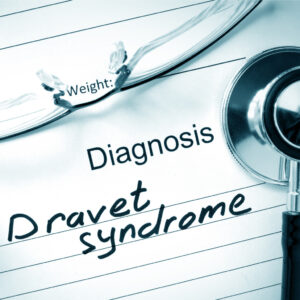Clinical Researcher—August 2023 (Volume 37, Issue 4)
RECRUITMENT & RETENTION
Veronica Hood, PhD; Mary Anne Meskis
Dravet syndrome (DS) is a rare disease with immense medical need that presents as a severe neurodevelopmental disorder characterized by multiple types of medication-resistant seizures that begin in infancy. Termed a Developmental and Epileptic Encephalopathy, DS includes more than just difficult-to-treat seizures; as patients age, accumulating symptoms include developmental delays and cognitive impairments, behavioral challenges, sleep disruptions, and movement issues. Patients also face a 15% to 20% premature mortality rate, most often due to Sudden Unexpected Death in Epilepsy.
DS is primarily caused by variants in a single gene, SCN1A, that cause a reduction in the number or function of sodium channels encoded by this gene.{1} Due to this underlying reduction in sodium channel function in the brain in DS, use of sodium channel blockers, a common type of antiseizure medication, can actually worsen seizures and other symptoms for these patients.
DS is considered a rare disease, impacting about one in every 15,700 live births, or approximately 18,000 individuals in the United States.{2} There are three antiseizure medications for DS approved by the U.S. Food and Drug Administration (FDA): pharmaceutical-grade cannabidiol (Epidiolex), stiripentol (Diacomit), and fenfluramine (Fintepla), as well as clear treatment guidelines that outline top-line treatment recommendations from experts.{3} Despite the concomitant use of multiple therapies, the majority of patients experience breakthrough seizures and significant symptom burden.
Unique Opportunities for Novel Clinical Interventions
Identification of the genetic cause of DS in 2001 expedited research through the ability to establish animal and cell models, as well as to develop treatments that more directly treat the underlying cause of the disease. For example, the potential of the serotonin pathway as a therapeutic target was underlined by zebrafish drug screens{4} and the subsequent success of human clinical trials for Fintepla.{5,6} Now there are four additional clinical studies exploring the ability of serotonin modulating drugs to reduce seizures in DS and related epilepsies. Additionally, new targeted genetic therapies are in development that have shown efficacy beyond seizure control in animal models of DS.
While the size of SCN1A creates a challenge to traditional gene-replacement approaches, researchers have uncovered other mechanisms of genetic regulation of SCN1A that can be targeted to increase expression of the healthy copy of the gene. In 2020, the first patients in a Phase I/II study received STK-001, an RNA-based therapy called an antisense oligonucleotide developed by Stoke Therapeutics that aims to increase expression of the healthy copy of SCN1A by targeting alternative splicing events. Several other approaches are in various stages of preclinical pipelines to similarly address DS at the genetic level.
As scientific understanding of DS continues to advance rapidly, there has also been a steady increase in access to free or low-cost genetic testing in the clinic. This has reduced the time from symptom onset to diagnosis for patients as well as helped to identify previously undiagnosed patients. Timely and accurate diagnosis can greatly guide clinical care for patients with DS, particularly alerting providers to the contraindication of sodium channel blockers. Moreover, accurate diagnosis allows the DS patient community the opportunity to organize and advocate.
Clinical Studies for Rare Diseases Require Unique Considerations
Trial participation for a patient with a rare disease that has significant medical needs can be challenging and adds to the already overwhelming caregiver burden on parents. Families often live a significant distance from trial locations, requiring long-distance travel by car or by air. For a patient with uncontrolled and unpredictable seizures, travel can be difficult and there are often last-minute changes or cancellations to the travel itinerary and clinic visit. The required time to travel and participate can result in financial barriers from missed work, as well as the care of other siblings in the household while the patient and parents are away. Associated comorbidities in DS add to the travel burden, with medical equipment such as adaptive strollers, incontinence products, special dietary products, and seizure monitoring devices needed at the destination.
The recent focus on decentralized clinical trials could help to reduce some of the barriers to participation for rare disease patients. Utilizing telehealth visits and wearable devices can help to cut down on the number of in-person visits and ease participation burden, allowing more opportunities for access and diversity in trial participation.
Patient Advocacy Groups Can Accelerate Research and Clinical Studies
A clear benefit of patient community organizations is the support and connection that can improve the quality of life of rare disease patients and their families. However, there can be surprisingly far-reaching impacts of patient advocacy groups on research and clinical trials for rare diseases. An organized, informed, and connected patient community can ease some of the challenges for clinical studies in rare disease populations.
In 2009, the Dravet Syndrome Foundation (DSF) was founded to unite the patient community around advancing research for DS. In pursuit of this mission, DSF has directed more than $6.7 million to early-stage academic research and has worked hard to establish an engaged clinical trial–ready community. The success of this is exemplified in part by the pivotal clinical studies in patients with DS that led to the approval of Epidiolex in 2018{7} and Fintepla in 2020.{5,6}
Clinical trials can be particularly challenging for rare diseases where the medical burden is high and patient populations are spread out geographically. Patient advocacy organizations like DSF can connect sponsors and clinical research organizations to key opinion leaders in the clinical and research spaces, as well as to institutions where expert healthcare providers are treating larger portions of the patient population. For example, DSF maintains a listing of Comprehensive Care Centers where healthcare providers have expertise in the treatment of DS and experience with clinical studies. These listings assist families in gathering information as they choose their primary care providers, and can be beneficial to consider when sponsors are planning study sites for interventional trials.
When trials are enrolling, patient groups can assist in raising awareness of participation opportunities among the relevant patient populations that are spread out geographically. The DS patient community remains tightly connected through in-person events and online forums organized by DSF. The DSF Family Network includes an informal contact registry and online support groups that allow DSF to notify families of opportunities to participate in clinical studies.
Patient advocacy groups can additionally provide access to the patient voice, such as assembling panels of patients or caregivers to help sponsors and investigators understand the patient community needs, select relevant outcome measures, determine the feasibility of trial participation, guide patient-facing educational materials, and establish appropriate support measures to ensure a successful trial. DSF actively engages in the creation and curation of robust educational materials that engage the community in understanding the importance of research, patient participation in studies, and general concepts surrounding clinical trials to maintain a clinical trial–ready patient community.
Lastly, patient advocacy organizations are playing an ever-increasing role in educating regulatory bodies on the real-life needs and impacts of rare diseases in ways that can inform decision-making around novel therapeutics by considering the true risk-benefit framework from the perspective of those living with rare disease. DSF worked with the patient community to hold an Externally-led Patient Focused Drug Development (EL-PFDD) Meeting and develop a subsequent Voice of the Patient Report that provides insight into the patient-family perspective on the burden of living with DS, experience with current treatments, and the unmet medical needs for those living with DS. The input from these meetings and reports can help to inform the FDA’s decision-making process, ensuring the patient perspective is considered in the benefit-risk assessment.
Professional Resources for Learning More About DS
With an ever-increasing number of identified rare diseases, it can be difficult for professionals to stay up to date on the most recent and accurate information. In addition to providing educational materials for the patient community, DSF curates resources for medical and research professionals related to DS, including:
- webinars created by expert clinicians specifically for healthcare professionals,
- overviews and links to the most recent diagnostic and treatment guidelines,
- the Dravet syndrome EL-PFDD meeting recording and Voice of the Patient Report, and
- a listing of actively enrolling clinical trials and an overview of the therapeutic pipeline for DS.
Conclusion
Given the growing scientific knowledge, robust therapeutic pipeline, and organized patient population, there is immense opportunity to develop successful treatments to address DS. As with any rare disease, there can be significant challenges to participation in clinical studies for patients and families navigating life with DS. However, collaboration and thoughtful study design that includes patients and patient organizations like DSF can ease the burden of trial participation and facilitate successful study completion.
References
- Li W, Schneider AL, Scheffer IE. 2021. Defining Dravet syndrome: An essential pre-requisite for precision medicine trials. Epilepsia. https://doi.org/10.1111/epi.17015
- Wu YW, Sullivan J, McDaniel SS, et al. 2015. Incidence of Dravet Syndrome in a US Population. Pediatrics 136:e1310–15. https://doi.org/10.1542/peds.2015-1807
- Wirrell EC, Hood V, Knupp KG, et al. 2022 International consensus on diagnosis and management of Dravet syndrome. Epilepsia. https://doi.org/10.1111/epi.17274
- Griffin A, Hamling KR, Knupp K, et al. 2017. Clemizole and modulators of serotonin signalling suppress seizures in Dravet syndrome. Brain aww342. https://doi.org/10.1093/brain/aww342
- Lagae L, Sullivan J, Knupp K, et al. 2019. Fenfluramine hydrochloride for the treatment of seizures in Dravet syndrome: a randomized, double-blind, placebo controlled trial. The Lancet 394(10216):2243–54.
- Nabbout R, Mistry A, Zuberi S, et al. 2020. Fenfluramine for treatment-resistance seizures in patients with Dravet syndrome receiving stiripentol-inclusive regimens: A randomized clinical trial. JAMA Neurology 77(3):300–8.
- Devinsky O, Cross JH, Laux L, et al. 2017. Trial of cannabidiol for drug-resistant seizures in the Dravet syndrome. The New England Journal of Medicine 376(21):2011–20.

Veronica Hood, PhD, is Scientific Director at the Dravet Syndrome Foundation.

Mary Anne Meskis is Executive Director at the Dravet Syndrome Foundation.



